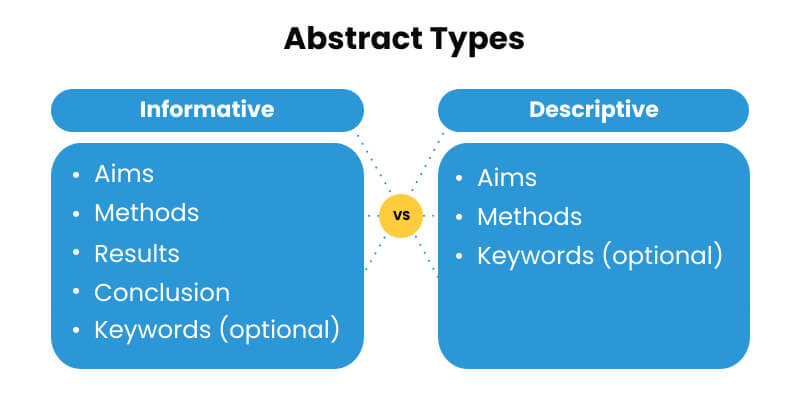Writing an abstract is one of the skills you need to master to succeed in your studies. An abstract is a summary of an academic text. It contains information about the aims and the outcomes of the research. The primary purpose of an abstract is to help readers understand what a particular paper is about. It serves as a sort of introduction to the paper. The usual length is about 150-300 words.
Types of abstract essays include descriptive, critical, highlight, and informative abstract.
This article by Custom Writing experts will help you write a perfect abstract. Not only we have an example of informative abstract but also the examples of other types too. Keep reading and good luck with your assignment!
🚦 How to Write an Abstract: Getting Started
There are several things to consider before you start writing an abstract.
- It would be best if you had your paper ready. This one should be a no-brainer, but it’s still worth mentioning. If you try to write your abstract first, chances are you’ll have to edit it a lot afterward.
- Make sure you’re aware of all the requirements: writing style, length, and the whole purpose of an abstract. All of these factors will influence the contents of your abstract. Again, it’s better to do everything right from the beginning than to edit your work later.
- Think of the audience. Remember the definition of an abstract? It helps readers understand what your work is about. You need to be aware of who’s going to read it. Are they going to be scientists who’ll use your abstract to decide whether your work is relevant? Or do you need to make your abstract easy to understand for anyone? Answering these kinds of questions will help you determine how your abstract will look.
- Decide on the type of abstract. This decision is an essential one. Therefore, we’ll talk about it in the next part of our guide.
📑 Abstract Structure & Types
There are two main types of abstracts: informative and descriptive. The former is also known as a complete abstract, while the latter contains less information. See more detailed information below.

Informative Abstract
This type of abstract writing is also known as a complete abstract. And it’s pretty self-explanatory. An informative abstract is a summary of a paper. It describes its purpose, methodology, background, results, and conclusion. It also includes information about the paper’s structure, its key thoughts, and the major topics discussed. How long should an informative abstract be? It usually sticks to around 250+ words. The completeness of the information provided in it makes it possible to use the informative abstract as an independent document. A format similar to informative abstracts is used to write short scientific reports. Apart from examples below, you can use a summary writing tool to generate your own and check out the structure using more materials.
Informative Abstract Example
Example:
The Internet of Things Provides Emerging Business Opportunities
Purpose: The Internet of Things (IoT) is a new phenomenon, so there is a lack of public and scientific understanding of what IoT is and what commercial opportunities it can offer for large companies and sole entrepreneurs. The article aims to stimulate creativity, thinking, and entrepreneurship in terms of IoT.
Methods: This article consists of three parts. In the first part, IoT is described as a wide socio-technical phenomenon. Second, this article suggests two approaches for establishing new business models using IoT: a disruptive and a sustainable approach. Third, the article concludes with a reflection on the time to which the future of IoT can be possibly predicted.
Scope: The article discusses different elements that comprise IoT in the physical, technological, and socioeconomic environments.
Results: This discussion shows the limitations of the new business models approach that was examined in this article and suggests guidelines on the more efficient ways of using this approach.
Conclusions: The attempt to predict the future can prepare companies for various threats and opportunities. The envisioned outcomes and scenarios can help the entrepreneurs make the correct decisions for their businesses’ success.
Descriptive Abstract
This type of abstract is also called a limited abstract. Again, the name says it all. This abstract type paints a general description of the paper without going into very in-depth details. In the case of an informative abstract, you can develop an opinion about the paper based on the abstract alone. With a descriptive abstract, though, you’ll still have to read the main work because the abstract will only provide a general idea without all the vital pieces of content. It’s more like a table of contents but written in the form of a paragraph. And it’s usually about 100-200 words long.
Descriptive Abstract Example
Example:
Exploring the Boundaries of the Social Sciences
Purpose: The concept of research boundaries has been critical in history, anthropology, sociology, social psychology, political science, and sociology. This article intends to explore this problem and analyze the relational processes hindered by the boundaries.
Methods: It addresses relatable processes in various research institutions and social locations. It also investigates the directions for further development, with a focus on the dependence between symbolic and social boundaries, their cultural mechanisms, hybridity and difference, and group classifications.
Scope: The article analyzes several works on social identity; class, ethnic, and gender inequality; professions and science; and national identities, communities, and territorial boundaries.
Indicative Abstract
Unlike an informative or descriptive abstract, an indicative abstract is written for less strictly structured works, such as essays or novels. It aims to define and explain the work’s central concepts, statements, and content.
Now, what is the typical structure of such an abstract?
In most cases, it looks like this:
- Paper’s scope. This part informs the reader about the general subject of your inquiry. It defines the subject and explains what specific aspect you’re researching.
- Your arguments. The list of arguments briefly covers your line of reasoning and presents your main ideas about the subject. This part may outline storyline development in an abstract for a book or other work that has a plot.
- Conclusion. The final part of the abstract will include your closing argument. If you’re writing an abstract for a work of fiction, it will contain a plot resolution.
The meaning of such an abstract is to indicate or pinpoint the main aspects of your content so that the readers are familiar with it before proceeding to the full text.
Indicative Abstract Example
Want to know how to write an indicative abstract? Here is an example you may follow:
Example:
Scope: The essay analyzes Qatar’s soft diplomacy approaches. It demonstrates how this state has secured an influential political standing in the Gulf region and the global political arena.
Arguments: Qatar has become a valuable interlocutor in many high-rank negotiations and peace talks due to collective and derivative power sources. These sources include formal ties with developed countries and active participation in regional alliances. It also has informal connections with hard-to-reach regional forces, such as the Taliban, Hamas, and Yemeni oppositional groupings. All these aspects make Qatar a preferred reference point for negotiating parties and secure the country’s interests in global politics.
Conclusion: The essay proves that Qatar is an example of a state that challenges the limited-capacity image of small countries. It shows how even small regional players can become valuable and influential in international relations.
👣 Writing an Abstract Step by Step
You’ll need to write an abstract for almost any academic text: a thesis, a research paper, an article, etc. No matter what document you are working on, the abstract should be the last part you’ll write. Let’s learn what main components that any abstract contains and how to write them step by step.
Identify Your Aims
Tell your readers why your work matters and why it is important. Don’t go into details here. Concentrate on the crucial points. Note that this part should be written in the present or past simple tense, not the future, as your research is already done. The questions below can help you formulate your aims.
- Why did I decide to study this particular topic?
- What theoretical or practical problem does my research respond to?
- What is the social context of my work?
- Why are my key findings important?
Explain Your Methods
The next part of your abstract is to contain a short and straightforward description of your research. Explain what you did in one or two sentences. Do that using the past simple tense.
- Describe your research process. Mention the approach you decided to go with and all the data that was at your disposal.
- Give a short overview of the most important sources used for your paper.
- Mention the evidence that supports your claims, so the readers know there’s a foundation to what you’re saying.
Share Your Results
This is where the main difference between the two types of abstracts comes into play.
You see, it’s only informative abstracts that contain this information. So, if you’ve decided to go with the descriptive type, you may skip this step.
If stating the problem can be considered a question, then this part is the answer to that question. Describe all your general findings as well as the goal that you reached through your research. Support your words with arguments and hypotheses.
Write a Conclusion
Not only will this part be a logical finish to your abstract, but it will also make a smooth transition to its closure.
Explain what your findings mean and why they make your paper important. To simplify the task, use an article summary generator and just edit the resulting piece.
While this part is necessary both for informative and descriptive abstracts, it’s only the former that needs to answer the following questions:
- What implications does my work have?
- Are my findings specific or general?
✏️ Abstract FAQ
How to Write an Abstract for a Manuscript?
An abstract is a compressed view of the essential elements of a manuscript without added interpretation. It should consist of an introduction or background, purpose, methodology, results, and discussion, or another conclusion. An effective abstract is not a selection of manuscript sentences, but a reworded gist.
How to Write an Abstract for a Presentation?
A presentation abstract shall provide an overview of the research as briefly as possible. It shall comprise context, objective, methodology, and findings. The total word count shall not exceed 250 words. You will present the research orally and visually at the conference, so the purpose is to raise the listeners’ curiosity rather than provide them with a summary of your work.
How to Write an Abstract for a Science Project?
It should be an easy-to-read 250-word passage following the template:
- The topic and purpose of your research or invention.
- The problem you resolved or the hypothesis you examined.
- The scientific methods you used to implement point 2.
- The achieved results.
- Conclusions on the relevance and importance of your project.
How to Write an Abstract for a Lab?
Identify the problem you address and give the reasons that motivated you to conduct the investigation. Mention the gaps that require further research. Describe your methodology. Provide the main results and findings without further explanation. The total number of words in an abstract shall be given in the lab requirements.
References
- How to Write an APA Abstract
- How to Write an Abstract—Parts of an Abstract and Checklist
- What are Structured Abstracts?
- Writing Report Abstracts
- Formatting Your Paper
- Make a Great First Impression: 6 Tips for Writing a Strong Abstract
- Science Fair Project Abstract Writing
- Writing a Research Abstract
- What Goes in an Abstract?


![How to Write a Research Paper Step by Step [2025 Upd.]](https://custom-writing.org/blog/wp-content/uploads/2020/12/research-charts-284x153.jpg)









Great article!
Thanks for sharing this blog with us. I am the regular reader of this website. Whenever I visited here find something meaningful. I will share this blog with my friends.
I have found this guide helpful and will be sharing the link with my students.